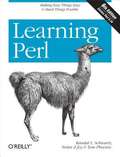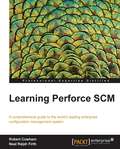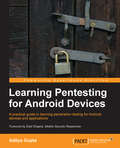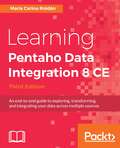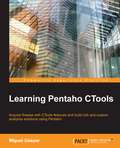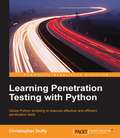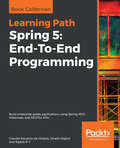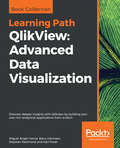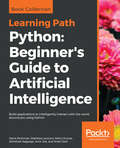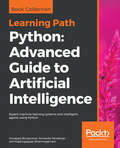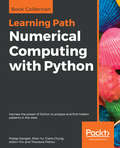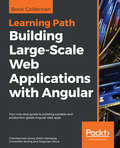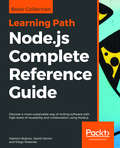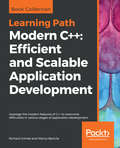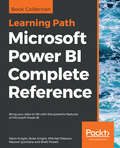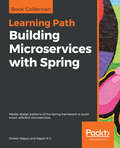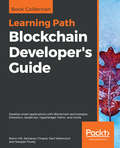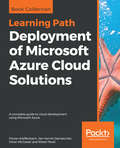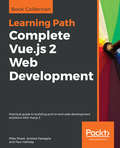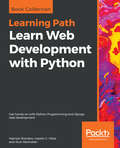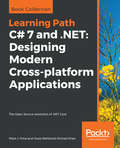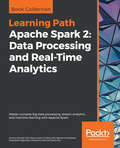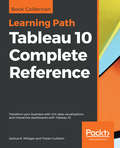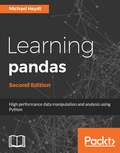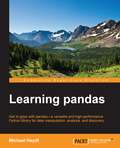- Table View
- List View
Learning Perl
by Randal L. Schwartz Tom Phoenix Brian D FoyIf you're just getting started with Perl, this is the book you want--whether you're a programmer, system administrator, or web hacker. Nicknamed "the Llama" by two generations of users, this bestseller closely follows the popular introductory Perl course taught by the authors since 1991. This 6th edition covers recent changes to the language up to version 5.14. Perl is suitable for almost any task on almost any platform, from short fixes to complete web applications. Learning Perl teaches you the basics and shows you how to write programs up to 128 lines long--roughly the size of 90% of the Perl programs in use today. Each chapter includes exercises to help you practice what you've just learned. Other books may teach you to program in Perl, but this book will turn you into a Perl programmer. Topics include: Perl data and variable types Subroutines File operations Regular expressions String manipulation (including Unicode) Lists and sorting Process management Smart matching Use of third party modules
Learning Perforce SCM
by Robert Cowham Neal Ralph FirthLearning Perforce SCM is written in a friendly and practical style with a focus on getting you started with Perforce efficiently and effectively. The book provides plenty of examples and screenshots to guide you through the process of learning."Learning Perforce SCM" is for anyone who wants to know how to adeptly manage software development activities using Perforce. Experience with other version control tools is a plus but is not required.
Learning Pentesting for Android Devices
by Aditya GuptaThis is an easy-to-follow guide, full of hands-on and real-world examples of applications. Each of the vulnerabilities discussed in the book is accompanied with the practical approach to the vulnerability, and the underlying security issue. This book is intended for all those who are looking to get started in Android security or Android application penetration testing. You don't need to be an Android developer to learn from this book, but it is highly recommended that developers have some experience in order to learn how to create secure applications for Android.
Learning Pentaho Data Integration 8 CE - Third Edition
by Maria Carina RoldanGet up and running with the Pentaho Data Integration tool using this hands-on, easy-to-read guide About This Book • Manipulate your data by exploring, transforming, validating, and integrating it using Pentaho Data Integration 8 CE • A comprehensive guide exploring the features of Pentaho Data Integration 8 CE • Connect to any database engine, explore the databases, and perform all kind of operations on relational databases Who This Book Is For This book is a must-have for software developers, business intelligence analysts, IT students, or anyone involved or interested in developing ETL solutions. If you plan on using Pentaho Data Integration for doing any data manipulation task, this book will help you as well. This book is also a good starting point for data warehouse designers, architects, or anyone who is responsible for data warehouse projects and needs to load data into them. What You Will Learn • Explore the features and capabilities of Pentaho Data Integration 8 Community Edition • Install and get started with PDI • Learn the ins and outs of Spoon, the graphical designer tool • Learn to get data from all kind of data sources, such as plain files, Excel spreadsheets, databases, and XML files • Use Pentaho Data Integration to perform CRUD (create, read, update, and delete) operations on relationaldatabases • Populate a data mart with Pentaho Data Integration • Use Pentaho Data Integration to organize files and folders, run daily processes, deal with errors, and more In Detail Pentaho Data Integration(PDI) is an intuitive and graphical environment packed with drag-and-drop design and powerful Extract-Tranform-Load (ETL) capabilities. This book shows and explains the new interactive features of Spoon, the revamped look and feel, and the newest features of the tool including transformations and jobs Executors and the invaluable Metadata Injection capability. We begin with the installation of PDI software and then move on to cover all the key PDI concepts. Each of the chapter introduces new features, enabling you to gradually get practicing with the tool. First, you will learn to do all kind of data manipulation and work with simple plain files. Then, the book teaches you how you can work with relational databases inside PDI. Moreover, you will be given a primer on data warehouse concepts and you will learn how to load data in a data warehouse. During the course of this book, you will be familiarized with its intuitive, graphical and drag-and-drop design environment. By the end of this book, you will learn everything you need to know in order to meet your data manipulation requirements. Besides, your will be given best practices and advises for designing and deploying your projects. Style and approach Step by step guide filled with practical, real world scenarios and examples.
Learning Pentaho CTools
by Miguel GasparAcquire finesse with CTools features and build rich and custom analytics solutions using Pentaho About This Book * Learn everything you need to know to make the most of CTools * Create interactive and remarkable dashboards using the CTools * Understand how to use and create data visualizations that can make the difference * The author of our book works for Pentaho as a Senior Consultant * Acts as a follow-up to Packt's previously published products on Pentaho such as Pentaho Business Analytics Cookbook, Pentaho Analytics for MongoDB, Pentaho Data Integration Cookbook - Second Edition, and Pentaho Reporting [Video] * Our book is based on the latest version of Pentaho, that is, 6.0 Who This Book Is For If you are a CTools developer and would like to expand your knowledge and create attractive dashboards and frameworks, this book is the go-to-guide for you. A basic knowledge of JavaScript and Cascading Style Sheets (CSS) is highly recommended. What You Will Learn * Install Community Tools on Pentaho; and understand the necessary concepts and considerations when creating an exciting dashboard design * Get data from many different Pentaho datasources and deliver it in different formats (CSV, XLS, XML, or JSON) * Use the Community Data Access (CDA) as the data abstraction layer and understand the concepts in the Community Dashboard Framework (CDF) * Create a Community Dashboard Editor (CDE) dashboard and make the most of the main components * Create and make use of widgets and use duplicate components to have data-driven sections on the dashboard * Customize and create interaction between all components, including charts, using the Community Charts Components * Create and embed dashboards in a better and new way * Create plugins and make use of parameters inside Pentaho without writing code In Detail Pentaho and CTools are two of the fastest and most rapidly growing tools for practical solutions not found in any other tool available on the market. Using Pentaho allows you to build a complete analytics solution, and CTools brings an advanced flexibility to customizing them in a remarkable way. CTools provides its users with the ability to utilize Web technologies and data visualization concepts, and make the most of best practices to create a huge visual impact. The book starts with the basics of the framework and how to get data to your dashboards. We'll take you all the way through to create your custom and advanced dashboards that will create an effective visual impact and provide the best user experience. You will be given deep insights into the lifecycle of dashboards and the working of various components. Further, you will create a custom dashboard using the Community Dashboards Editor and use datasources to load data on the components. You will also create custom content using Query, the Freeform Addins Popup, and text components. Next, you will make use of widgets to create similar sections and duplicate components to reproduce other components on a dashboard. You will then learn to build a plugin without writing Java code, use Sparkl as a CPK plugin manager, and understand the application of deployment and version control to dashboard development. Finally, you will learn tips and tricks that can be very useful while embedding dashboards into other applications. This guide is an invaluable tutorial if you are planning to use custom and advanced dashboards among the solutions that you are building with Pentaho. Style and approach This book is a pragmatic, easy-to-follow guide that provides theoretical concepts, ideas, and tricks to better understand the necessary theoretical concepts. It also provides you with a set of highly intriguing samples of dashboards with customized code within them that can be utilized for future projects.
Learning Penetration Testing with Python
by Christopher DuffyUtilize Python scripting to execute effective and efficient penetration tests About This Book * Understand how and where Python scripts meet the need for penetration testing * Familiarise yourself with the process of highlighting a specific methodology to exploit an environment to fetch critical data * Develop your Python and penetration testing skills with real-world examples Who This Book Is For If you are a security professional or researcher, with knowledge of different operating systems and a conceptual idea of penetration testing, and you would like to grow your knowledge in Python, then this book is ideal for you. What You Will Learn * Familiarise yourself with the generation of Metasploit resource files * Use the Metasploit Remote Procedure Call (MSFRPC) to automate exploit generation and execution * Use Python's Scrapy, network, socket, office, Nmap libraries, and custom modules * Parse Microsoft Office spreadsheets and eXtensible Markup Language (XML) data files * Write buffer overflows and reverse Metasploit modules to expand capabilities * Exploit Remote File Inclusion (RFI) to gain administrative access to systems with Python and other scripting languages * Crack an organization's Internet perimeter * Chain exploits to gain deeper access to an organization's resources * Interact with web services with Python In Detail Python is a powerful new-age scripting platform that allows you to build exploits, evaluate services, automate, and link solutions with ease. Python is a multi-paradigm programming language well suited to both object-oriented application development as well as functional design patterns. Because of the power and flexibility offered by it, Python has become one of the most popular languages used for penetration testing. This book highlights how you can evaluate an organization methodically and realistically. Specific tradecraft and techniques are covered that show you exactly when and where industry tools can and should be used and when Python fits a need that proprietary and open source solutions do not. Initial methodology, and Python fundamentals are established and then built on. Specific examples are created with vulnerable system images, which are available to the community to test scripts, techniques, and exploits. This book walks you through real-world penetration testing challenges and how Python can help. From start to finish, the book takes you through how to create Python scripts that meet relative needs that can be adapted to particular situations. As chapters progress, the script examples explain new concepts to enhance your foundational knowledge, culminating with you being able to build multi-threaded security tools, link security tools together, automate reports, create custom exploits, and expand Metasploit modules. Style and approach This book is a practical guide that will help you become better penetration testers and/or Python security tool developers. Each chapter builds on concepts and tradecraft using detailed examples in test environments that you can simulate.
Learning Path - Spring 5: End to End Programming
by Rajesh R V Dinesh Rajput Claudio Eduardo OliveiraIf you're a developer starting out with Spring, then this learning path will help you learn about the new Spring 5.0 framework concepts followed by their implementation in Java and Kotlin. If you are an experienced Spring developer, then this Learning Path will enable you to gain insights into the new features added in Spring 5.0.
Learning Path - QlikView: Advanced Data Visualization
by Karl Pover Stephen Redmond Barry Harmsen Miguel Angel GarciaThis Learning Path is designed for developers who want to go beyond their technical knowledge of QlikView and understand how to create analysis and data visualizations that solve real business needs. To grasp the concepts explained in this Learning Path, you should have a basic understanding of the common QlikView functions and some hands-on experience with the tool.
Learning Path - Python: Beginner's Guide to Artificial Intelligence
by Md. Rezaul Karim Giancarlo Zaccone Vahid Mirjalili Sebastian Raschka Denis RothmanThis Learning Path is for anyone who wants to understand the fundamentals of Artificial Intelligence and implement it practically by devising smart solutions. You will learn to extend your machine learning and deep learning knowledge by creating practical AI smart solutions. Prior experience with Python and statistical knowledge is essential to make the most out of this Learning Path.
Learning Path - Python: Expert Machine Learning Systems And Intelligent Agents Using Python
by Rajalingappaa Shanmugamani Armando Fandango Giuseppe BonaccorsoThis Learning Path is for data scientists, machine learning engineers, artificial intelligence engineers who want to delve into complex machine learning algorithms, calibrate models, and improve the predictions of the trained model. You will encounter the advanced intricacies and complex use cases of deep learning and AI. A basic knowledge of programming in Python and some understanding of machine learning concepts are required to get the best out of this Learning Path.
Learning Path - Python: Harness The Power Of Python To Analyze And Find Hidden Patterns In The Data
by Theodore Petrou Aldrin Yim Claire Chung Allen Yu Pratap DangetiIf you want to learn how to use the many libraries of Python to extract impactful information from your data and present it as engaging visuals, then this is the ideal Learning Path for you. Some basic knowledge of Python is enough to get started with this Learning Path.
Learning Path - Professional Web Development with Angular: Your One-stop Guide To Building Scalable And Production-grade Angular Web Apps
by Doguhan Uluca Christoffer Noring Kevin Hennessy Chandermani AroraThis Learning Path is designed for JavaScript and frontend developers who want to get a comprehensive practical experience on using Angular for end-to-end enterprise-ready applications.
Learning Path - Node.js Complete Reference Guide: Discover A More Sustainable Way Of Writing Software With High Levels Of Reusability And Collaboration Using Node. Js
by Diogo Resende David Herron Valentin BojinovNode.js Complete Reference Guide is designed for web developers who have a rudimentary understanding of JavaScript and web application development, are keen to enrich their development skills to create RESTful applications, and want utilize their skills to build microservices.
Learning Path - Modern C++: Efficient and Scalable Application Development
by Marius Bancila Richard GrimesThis Learning Path is designed for developers who want to gain a solid foundation with C++. A computer, an Internet connection, and the desire to learn how to code in C++ are all you need to get started with this Learning Path.
Learning Path - Microsoft PowerBI Complete Reference: Bring Your Data To Life With The Powerful Features Of Microsoft Power Bi
by Brett Powell Manuel Quintana Mitchell Pearson Brian Knight Devin KnightMicrosoft Power BI Complete Reference Guide is for those who want to learn and use the Power BI features to extract maximum information and make intelligent decisions that boost their business. If you have a basic understanding of BI concepts and want to learn how to apply them using Microsoft Power BI, then Learning Path is for you. It consists of real-world examples on Power BI and goes deep into the technical issues, covers additional protocols, and much more.
Learning Path - Getting Started with Spring Microservices: Master design patterns of the Spring framework to build smart, efficient microservices
by Dinesh Rajput Rajesh R VGetting Started with Spring Microservices is ideal for Spring developers who want to use design patterns to solve common design problems and build cloud-ready, Internet-scale applications, and simple RESTful services.
Learning Path - Getting Started with Blockchain: Develop Smart Applications With Blockchain Technologies - Ethereum, Javascript, Hyperledger Fabric, And Corda
by Narayan Prusty Paul Valencourt Samanyu Chopra Brenn HillGetting Started with Blockchain is for you if you want to get to grips with the blockchain technology and develop your own distributed applications. It is also designed for those who want to polish their existing knowledge regarding the various pillars of the blockchain ecosystem. Prior exposure to an object-oriented programming language such as JavaScript is needed.
Learning Path - Deploying Azure Solutions: A Complete Guide To Cloud Development Using Microsoft Azure
by Ritesh Modi Oliver Michalski Jan-Henrik Damaschke Florian KlaffenbachDeploying Azure Solutions is for IT architects, system and network admins, and DevOps engineers who are aware of Azure solutions and want to implement them for their organization. Prior basic knowledge of the Azure Cloud platform is good to have.
Learning Path - Complete Vue.js 2 Web Development: Practical Guide To Building End-to-end Web Development Solutions With Vue. Js 2
by Paul Halliday Andrea Passaglia Mike StreetThe Learning Path is intended for JavaScript developers at any level of expertise who wants to learn Vue.js and develop productive web applications with the power of the latest Vue.js.
Learning Path - Complete Python Web Development with Django: Get hands-on with Python Programming and Django web development
by Arun Ravindran Gaston C. Hillar Antonio MeleThis Learning Path is designed for Python developers who want to create robust web apps with Django. Though you need a basic working knowledge of Django, you do not need any previous experience with RESTful web services or Python.
Learning Path - C# 7 and .NET: The Open Source Revolution Of . Net Core
by Ovais Mehboob Khan Mark J. PriceThis Learning Path is designed for developers who want to gain a solid foundation with C# and .NET Core, and want to build cross-platform applications. To gain maximum benefits from this Learning Path, you must have the basic knowledge of C#.
Learning Path - Apache Spark 2: Master Complex Big Data Processing, Stream Analytics, And Machine Learning With Apache Spark
by Meenakshi Rajendran Siamak Amirghodsi Sridhar Alla Md. Rezaul Karim Romeo KienzlerIf you are an intermediate-level Spark developer looking to master the advanced capabilities and use-cases of Apache Spark 2.x, this Learning Path is ideal for you. Big data professionals who want to learn how to integrate and use the features of Apache Spark and build a strong big data pipeline will also find this Learning Path useful. To grasp the concepts explained in this Learning Path, you must know the fundamentals of Apache Spark and Scala.
Learning Path – Getting Started with Tableau 10: Transform Your Business With Rich Data Visualizations And Interactive Dashboards With Tableau 10
by Donabel Santos Joshua MilliganGetting Started with Tableau 10 is designed for business intelligence users and data analysts who want to expand their data visualization knowledge by learning Tableau 10.
Learning pandas - Second Edition
by Michael HeydtGet to grips with pandas—a versatile and high-performance Python library for data manipulation, analysis, and discovery About This Book • Get comfortable using pandas and Python as an effective data exploration and analysis tool • Explore pandas through a framework of data analysis, with an explanation of how pandas is well suited for the various stages in a data analysis process • A comprehensive guide to pandas with many of clear and practical examples to help you get up and using pandas Who This Book Is For This book is ideal for data scientists, data analysts, Python programmers who want to plunge into data analysis using pandas, and anyone with a curiosity about analyzing data. Some knowledge of statistics and programming will be helpful to get the most out of this book but not strictly required. Prior exposure to pandas is also not required. What You Will Learn • Understand how data analysts and scientists think about of the processes of gathering and understanding data • Learn how pandas can be used to support the end-to-end process of data analysis • Use pandas Series and DataFrame objects to represent single and multivariate data • Slicing and dicing data with pandas, as well as combining, grouping, and aggregating data from multiple sources • How to access data from external sources such as files, databases, and web services • Represent and manipulate time-series data and the many of the intricacies involved with this type of data • How to visualize statistical information • How to use pandas to solve several common data representation and analysis problems within finance In Detail You will learn how to use pandas to perform data analysis in Python. You will start with an overview of data analysis and iteratively progress from modeling data, to accessing data from remote sources, performing numeric and statistical analysis, through indexing and performing aggregate analysis, and finally to visualizing statistical data and applying pandas to finance. With the knowledge you gain from this book, you will quickly learn pandas and how it can empower you in the exciting world of data manipulation, analysis and science. Style and approach • Step-by-step instruction on using pandas within an end-to-end framework of performing data analysis • Practical demonstration of using Python and pandas using interactive and incremental examples
Learning pandas
by Michael HeydtIf you are a Python programmer who wants to get started with performing data analysis using pandas and Python, this is the book for you. Some experience with statistical analysis would be helpful but is not mandatory.
